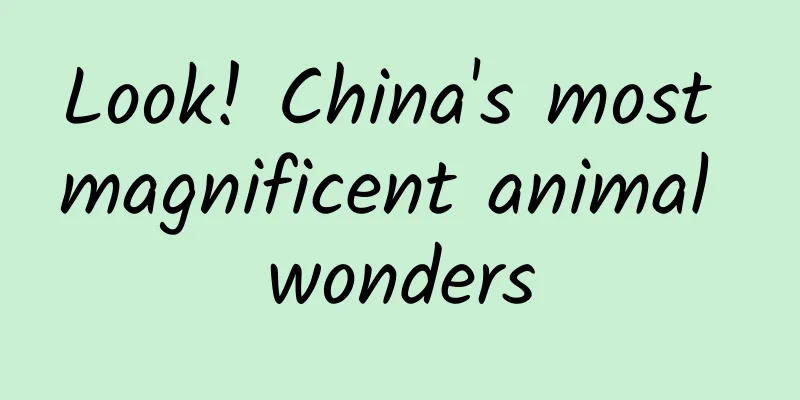Look! China's most magnificent animal wonders

|
This is the most magnificent animal wonder in nature Tens of thousands of horses are galloping across the land A surging "river of life" Flowing majestically "Rivers" flowing across the wild African grasslands (This is the greatest migration in the world, with more than 1 million wildebeests, 150,000 zebras and 350,000 gazelles migrating from the Serengeti to the Masai Mara. Image source: Visual China) ▼ Flowing on the vast snowfield (In order to find food and other reasons, Siberian reindeer migrate more than 1,000 kilometers each year. Image source: Visual China) ▼ This "river" is composed of Ungulates (Ungulata) They never stop and are at home everywhere The clanging of iron hooves plays a hymn to life (Zebra migration in the grasslands of Kenya, Africa. This torrent of life raises dust and crosses the vast land. Image source: @Visual China) ▼ Such magnificent animal wonders are not far away from us The footprints of ungulates have long been found all over China. China is also staging the "greatest journey in the animal world" On the vast Qinghai-Tibet Plateau Tibetan wild donkey (Equus kiang) The pace is neither slow nor fast, and never stops (Tibetan wild donkeys are extremely drought-resistant and can go without water for several days. In areas with dry climates and scarce water sources, Tibetan wild donkeys are a rare source of life. Image source: @Visual China) ▼ In the cold Hoh Xil Tibetan Antelope (Pantholops hodgsonii) Fast but elegant steps (The Tibetan antelope is a spirit of nature, dancing gracefully in the cold wind of the plateau. Photographer: @王鹤) ▼ How do they embrace China's vast mountains and rivers with their hooves? What kind of life legend has been written? 01 Iron Hoofs Clink Ungulates A complex and large family of animals Hoofs are a common feature of most of their members. But it's not actually the foot. But toes with nails wrapped (The galloping horses have brisk and steady steps. They have strong hips and slender lower limbs, and their bodies seem to be born for running. Image source: Visual China) ▼ Compared to humans, which use their feet to support their bodies Ungulates are like dancing ballerinas Walking and running on tiptoe (The representative animals of the zhí walking style include primates, bears and rodents, etc.; the toe walking style includes birds, cats, canines, etc.; the hoof walking style includes various ungulates, map by @张琪/Planet Research Institute, picture source @Visual China) ▼ Although they all have hooves However, within the ungulate family Divided into two major schools A group including horses, rhinos and tapirs (mò) They often have an odd number of toes Perissodactyla (Perissodactyla) The other includes cattle, sheep, etc. They usually have an even number of toes. Artiodactyla (Artiodactyla) (Each foot of the even-toed ungulate generally has 2 or 4 toes, and each foot of the odd-toed ungulate generally has 1 or 3 toes. However, classification by the number of toes is the traditional morphological classification method. There are some exceptions, such as the tapir of the odd-toed ungulate with 4 toes on the front feet and 3 toes on the back feet, and the whale of the even-toed ungulate with 5 toes on the front fin. Map by @张琪/星球研究院, picture source @视觉中国) ▼ The two families of Perissodactyla and Artiodactyla It can be said that "one family is happy, the other is worried" The prosperity of even-toed ungulates and the decline of odd-toed ungulates A sharp contrast Artiodactyls are extremely diverse There is not only a family of deer leaping through the forest There is also a cattle family consisting of various types of cattle, sheep, and antelopes Even whales and dolphins that swim in the ocean belong to the order Artiodactyla. (The ancestors of whales and dolphins originated from even-toed ungulates more than 50 million years ago. They are merged into the order Artiodactyla, also commonly known as Artiodactyla. Photographer @周杞楠) ▼ China is the country with the richest ungulate species in the world There are 61 species, accounting for about a quarter of the world There are only three species of Perissodactyla Ancestor of Perissodactyls Dating back 56 million years A group of animals called " Eohippus " They are only the size of a fox. Limbs with distinct toes They feed on young leaves and wild fruits in the rainforest. Similar to the tapirs that live in the rain forest today (Eohippus originated mainly in North America [Eohippus fossils have also been found in Europe], and is a small animal with a shoulder height of only 30 to 60 cm. It has 4 toes on its front feet and 3 toes on its back feet. It is the most primitive horse. Map by @张琪/星球研究院, image source @wikimedia commons) ▼ About 34 million years ago The Earth's temperature plummeted and Antarctica was covered with ice Large areas of forest were replaced by grasslands A "mass extinction" is coming quietly Grasslands are different from forests Without the cover of tall trees The only way to survive is to outrun the predator. In the great waves of life and death race The horse that is good at running is born The horse's paws are raised higher than those of its ancestors. Hoofwalking, running on tiptoe Like walking on stilts, you can greatly increase the length of your legs Increase running stride To improve grip when running The horse's middle toe becomes thicker and wider The other toes gradually degenerate Eventually evolved into today's single-toed horse (The number of toes is just a trend in evolution, and there is no strict order of precedence. Map by @张琪/Planetary Research Institute) ▼ Now in the Gobi Desert in northwest China We can also see the figure of Perissodactylus Przewalski's horse (Equus ferus przewalskii) Wandering there (Przewalski's horse is not a "wild horse" in the true sense. It may be a horse that escaped into the wild after being domesticated by the Botai people. It's just that it was domesticated for a short time and still retains some primitive characteristics. Image source: @Visual China) ▼ Compared with the unrestrained and elegant domestic horses Przewalski's horse looks stupid The mane is not as flowing as a domestic horse, but a short and straight Mohawk hairstyle. But their vision, smell and hearing are very sensitive. If disturbed, they can escape immediately (The Przewalski's horse has a larger head, sturdier limbs, and longer ears than domestic horses. Image source: Visual China) ▼ Like Przewalski's horses, there are also Mongolian wild ass (Equus hemionus) Tall and strong figure, slender limbs Like an indomitable fighter in the desert (Mongolian wild donkeys often move in groups, with a group of up to a hundred individuals. They live near water and grass and have strong adaptability to harsh environments. Image source: Visual China) ▼ Perissodactyls are fully adapted to grassland life But their dominance over the grasslands no longer exists. Today, the vast and fertile grasslands are dominated by even-toed ungulates . To cope with the pursuit of grassland carnivores Even-toed ungulates also evolved hooves specialized for running. But they belong to different schools Perissodactyls belong to the "one-finger Zen" Artiodactyls use two toes to run Among them, the Tibetan antelope is the fastest even-toed ungulate animal in China. They can reach speeds of up to 60 kilometers per hour Enough to leave predators far behind (Timid but alert Tibetan antelopes often appear in remote alpine deserts, semi-deserts and grasslands. Image source: Visual China) ▼ Even-toed ungulates and odd-toed ungulates are equally good at running But they are better at jumping. The hind limbs of even-toed ungulates can bend and extend to a great extent. Plus strong back and hind leg muscles So that they can easily jump four or five meters high Sika Deer (Cervus nippon) Known as the "Asian Sacred Deer" They are good at continuous long-distance jumps. Can move freely in the bushes, appearing and disappearing from time to time (The sika deer is the most familiar deer species. Its symbol is its sika spots, but these spots only appear in spring and summer. In autumn and winter, it will grow gray fur to keep out the cold. It is fast and agile, and its posture is graceful and elegant. Image source: Visual China) ▼ Roe deer (Capreolus pygargus) Living in the Greater Khingan Range They have excellent jumping ability. Speed and endurance are also among the best (The inside of the roe deer's tail is white. When frightened, it will lift up, exposing its white buttocks to warn and confuse its predators. Image source: Visual China) ▼ Blue Sheep (Pseudois nayaur) Maximize your jumping ability You can stroll along the cliffs It can jump up to 2-3 meters high. Can jump more than 10 meters without getting hurt Jump to avoid the pursuit of snow leopards and gray wolves (The blue sheep always stay near the cliffs. Once they encounter danger, they will immediately run to the steep hillside. At the same time, they will also scream to warn their peers to guard against the invasion of natural enemies. Image source: @Visual China) ▼ The nails of the mountain goat's hooves are hard and long Like the pitons used by humans in rock climbing Can be firmly inserted into rock cracks The soles of the feet also have soft pads to prevent slipping Allowing them to jump freely between cliffs It's like an elegant and dangerous cliff ballet (The mountain goat was born to climb rocks. If you give it a few prominent fulcrums, it can climb up the steep cliffs. Photographer @吴玮) ▼ It is not enough for ungulates to be slightly better in hooves Running and jumping are not their primary way of conquering the world. They also have a secret weapon - eating 02 Iron teeth and copper teeth Most ungulates eat grass But eating grass is not a bad way to survive Grass is difficult to digest and has no nutritional value Any animal that can eat grass There is some effort on their part. (Grass is more difficult to digest than leaves and buds because it contains a lot of cellulose, hemicellulose and lignin. Image source: Visual China) ▼ In the tropical rain forest of Xishuangbanna There lived an animal similar in size to a rabbit. Mouse deer (Tragulidae) (“鼷” means little mouse. Fifty million years ago, the even-toed ungulates were probably about the same size as the mouse deer. Image source: Visual China) ▼ Such a weak animal But it has a special ability - rumination It can swallow the food whole. After a while of eating Spit out the food you just ate into your mouth Chew again and swallow it back into the stomach for digestion (Rumination mainly occurs in even-toed ungulates, including members of the suborder ruminants, such as Bovidae and Cervidae. Although camels are not members of the suborder ruminants, they also chew the cud. Photographer @严大卫) ▼ Rumination gave even-toed ungulates an absolute advantage in occupying grasslands They can gobble it up first Then hide in a safe place and eat slowly Better protection from grassland predators For better digestion of grass Most artiodactyls have multiple stomachs Different stomachs have different digestive functions Able to digest cellulose-rich forage quickly and efficiently (Among even-toed ungulates, except pigs, all have more than one stomach. Map by @张琪/Planetary Research Institute. Image source: @Visual China) ▼ The entire order Artiodactyla, represented by ruminants It rose rapidly about 30 million years ago Formed a very diverse animal family including cattle, sheep, deer, etc. Today, 90% of even-toed ungulates are ruminants. Based on the principle of "being able to eat is a blessing" Even-toed ungulates can adapt to many harsh environments Constantly challenging the limits of survival The quicksand of Tarim, the snowfields of Saibei, and the meadows of the Qinghai-Tibet Plateau They are everywhere. (A herd of yaks migrating in the Tanggula Mountains of Tibet, image source: Visual China) ▼ Wild Camel (Camelus ferus) Living in an arid desert with poor soil Large amounts of fat stored in the hump Can be converted into energy and water when necessary This is the secret of camels being able to survive for half a month without food or water. (Wild camels walking in front of the Gobi and Yadan landforms in the West Lake National Nature Reserve in Dunhuang, Gansu Province, photographer @吴玮) ▼ Camels have hard papillae in their mouths Like two iron plates crushing hard food Can chew a thorny cactus with ease (The camel with iron teeth and copper fangs can eat thorny plants without getting hurt. Map by @张琪/Planetary Research Institute, image source: @Visual China) ▼ Camels can travel freely in the desert The reindeer (Rangifer tarandus) You can "cross the forest and the snowfield" They live in the boreal coniferous forests in the northern part of the Greater Khingan Range. When hungry, they eat moss; when thirsty, they lick the snow on the ground. The deer are galloping, mighty and powerful, and the momentum is soaring to the sky Therefore, reindeer are also known as "the boat of the forest sea". (The reindeer's wide hooves make them more suitable for running in the snowy forests. Image source: Visual China) ▼ On the Qinghai-Tibet Plateau Himalayan musk deer and Himalayan tahr sheep live here They like to eat usnea, moss and many types of rhododendron (The Himalayan Tahr sheep mainly inhabits the southern slopes of the Himalayas at an altitude of 3,000 to 4,000 meters, on hillsides with trees, and often moves around in rugged bare rock mountains and forest edges. Image source: Visual China) ▼ Rumination is the secret of the survival of the ungulate family But there are always members who take an unconventional approach and do not follow the rules Even against the decision of our ancestors Wild Boar (Sus scrofa) Simply give up the habit of eating grass and become an omnivore They neither ruminate nor have a well-developed stomach. They have a rich diet: insects, plant roots, wild flowers, and wild fruits. Who says wild boars can’t eat fine bran? (Wild boars are picking the red berries of the Nordic rowan. They eat almost everything. Image source: @Visual China) ▼ Maybe it’s because I ate too much. They focus most of their energy on competing for territory and mates. Most males carry weapons: long fangs Not just wild boars Deer (Hydropotes inermis) and Musk Deer (Moschidae) It also has long fangs The upper canine teeth of male musk deer are about 10 cm long. Like a sharp dagger that can cut through flesh (The long fangs of musk deer. In addition to musk deer and musk deer, many primitive members of the Cervidae family have long upper canine teeth, while most of the living deer have degenerated. Map by @张琪/Planetary Research Institute, picture source @Visual China) ▼ Compared to fang melee combat Horn fighting is the mainstream of even-toed ungulates Bovidae, Cervidae Their horns have various shapes. Some are like a knight's elegant sword (The Tibetan antelope's horns are very symmetrical and usually no longer than 60 centimeters. When viewed from the side, it looks like it has only one horn, hence the name "unicorn". Image source: Visual China) ▼ Some are like a pair of huge wings (Moose horns, like sculptures of nature, stand majestically and solemnly in the vast land of the north. Image source: @Visual China) ▼ Some look like a beautiful coral (The antlers of sika deer are elegant and upright, with complex branches, which endow the sika deer with vitality. Image source: Visual China) ▼ But the horned animals we see today They are far from their ancestors. When we open the stratum You will see bigger and more bizarre angles. (Megahorn deer, the antlers can be up to 4 meters long from one end to the other, map @张琪/Planet Research Institute, picture source @Visual China) ▼ Bovine horns have a hollow chamber Hence the name "hole corner" It can grow forever and never fall. Compared to the lifelong possession of horns, never return or exchange The antlers are new every year It falls off every year and grows again in the next spring. (The deer in the picture is an elk, and the antelope is an impala; the horns of even-toed ungulates are mainly divided into: hole horns of the Bovidae family and real horns of the Cervidae family. Map by @张琪/Planetary Research Institute, picture source @Visual China) ▼ The antlers are initially cartilaginous. Round and soft Called "deer antler" Deer antler contains a large number of blood vessels and nerves. It is quite sensitive, so bucks never use it in fights. (Scientists have discovered that the proliferation and development of antler cells is extremely fast, which is of great research value. Domestic deer can usually have their antlers harvested after anesthesia, without much harm to the deer themselves. Image source: Visual China) ▼ After 2 to 4 months of antler growth The cartilage inside will gradually turn into hard bone Degeneration of blood vessels and nerves, loss of pain sensation This is the mating season for deer. Antlers become the weapon for male deer to compete within the species and defend against natural enemies. (Males have reached their "peak of life" and are starting to fight for mates, photographer @孙华金) ▼ Wait until the mating season is over After completing their mission, the antlers will naturally fall off to conserve energy. Waiting for a new pair to grow in the spring of the following year (After the battle, this sika deer became a "one-horned deer", but don't worry, it will grow a new pair of horns next year. Photographer @马天旭) ▼ Horns are weapons for fighting for territory It is also a sign to attract the opposite sex The emergence of horns greatly enriched the species of ungulates Compared to weight suppression Even if the horn is broken, it will not be fatal. This is a relatively more flexible and less costly way of fighting. The rise of the herbivorous even-toed ungulates Perissodactyls also adapted to grassland life during their long evolution. Horses evolved teeth about 8 cm long Called "high crown tooth" To withstand the wear and tear of chewing roughage They do not have the ability to ruminate or a well-developed stomach structure. But it has a cecum and colon to digest grass Even so It is also difficult for them to shake the position of artiodactyls among herbivores (Horses have very long, high-crowned teeth, most of which are hidden under the gums and can continue to grow throughout their lives to cope with the wear and tear caused by chewing food. Map by @张琪/星球研究院, image source @视觉中国) ▼ Ungulate animals use their hooves to run and jump Have iron teeth and copper jaws to efficiently ingest food Use sharp horns for defense and competition It is these talents and skills that They can only be found on China's 9.6 million square kilometers of land. Crossing the barriers of space Running non-stop for survival Eventually formed the greatest animal wonder in nature Migration 03 A long road ahead Among the known extant ungulates Nearly half of species migrate Ungulates chase the lush grasslands The seasonally changing grassland plants are like green waves Driving their migration They crossed the mountains and rivers of China in an orderly manner Like a flowing painting (Elk migrate in the green waves. The most mainstream view is that the purpose of migration of ungulates is survival and reproduction. They wander between grasslands, cross mountains and rivers, and travel thousands of miles. Photographer @Sun Huajin) ▼ Tibetan wild donkeys live on the Qiangtang Plateau at an altitude of more than 4,000 meters. The air is thin and cold, and the rivers are crisscrossed They gather in groups during the day to forage for food in pastures with water sources. In the evening, we returned to the depths of the mountains to rest. Wandering 30 kilometers a day Must be the champion of the local "step count ranking" (Please watch in horizontal mode, Tibetan wild donkeys migrating in Ali, Tibet. They migrate mainly to find new food and water sources. The climate conditions in the plateau area are harsh and the growth of grassland vegetation is limited, so they need to migrate continuously to adapt to environmental changes. Photographer @山风) ▼ When migrating, Tibetan wild donkeys like to line up in a long line and walk in a line. Often walk along a fixed route Wherever they pass, they form "donkey trails" (Donkey trails usually surround pastures or water sources so that donkeys can forage and drink water in an orderly manner, and it is also convenient for herders to manage and care for the donkeys. Image source: Visual China) ▼ Compared to Tibetan wild donkey Wild Yak (Bos mutus) Their migration is larger They live in alpine grasslands or desolate cold desert areas Spend most of the day eating Wandering around while eating They usually gather in groups of dozens or even hundreds. Looking down from the sky, it looks like a black cloud Passing across the vast wasteland (Please watch in horizontal mode. Wild yaks migrate back and forth according to different seasons. When snow covers the plateau in winter, they migrate to lower altitudes. In summer, they return to high altitudes to enjoy fresh grass. Photographer @毛江涛) ▼ The most spectacular thing is the migration of Tibetan antelopes. With African wildebeest and arctic reindeer It is also called the world's most spectacular migration of ungulates. Tens of thousands of female Tibetan antelopes gather into a huge group They all went to Zhuonai Lake in the heart of Hoh Xil to give birth. (Please watch in horizontal mode. The migrating Tibetan antelopes are mainly female. Every May and June, the ewes will migrate to the lambing grounds to give birth to their calves, and then the female antelopes will lead their calves back the same way, completing a journey of up to 300 kilometers. There are also some populations of Tibetan antelopes that do not migrate. They are mainly distributed in the southern part of Qiangtang. Map by @陈景逸/星球研究院) ▼ Scientists believe their migration is not instinctive It comes from memories passed down from generation to generation. They only know "Mom" went there to give birth to her “Grandma” gave birth to my mother there ...... (Please watch in horizontal mode. The reason for the migration of Tibetan antelopes is still a mystery, but research has found that the migration behavior of Tibetan antelopes and many other ungulates is actually the result of acquired learning rather than innate instinct. Photographer @沛劲德) ▼ These memories It is also passed down from generation to generation among their individuals. Like a call from ancient times Eventually, a magnificent migration spectacle was formed. If we talk about the migration of Tibetan antelope It is the inheritance of the memory of ancestors So, we can describe the footprints of ungulates over millions of years. You will find that they carry the memories of the earth's mountains and rivers We always believe that life is fleeting, but mountains and rivers are eternal But ungulates allow us to see Life can also transcend time and space Record this immortal Jiangshan Witness the history and vicissitudes of this land Iron teeth and copper teeth It is the mark of the replacement of forest and grassland Galloping Horses It is a witness to the alternation of glaciers and oceans. (About 2.6 million years ago, under the influence of the fourth ice age, the sea level of the Bering Strait dropped, forming a land bridge. The ancestors of modern horses spread from North America to the world through the Bering Strait. Map by @Chen Jingyi/Planetary Research Institute) ▼ They span time and space Carrying the memory of mountains and rivers Run wild On them Carving the past and future of this land (Wild deer on the beach in Yancheng, Jiangsu, photographer @陶洪) ▼ This article was created by Written by : Gu Yuehu Image : Liu Yude Map : Chen Jingyi Design : Zhang Qi Reviewer : Mirror & Li Moli & Gao Liqian Cover source : Tao Hong Expert review Deng Tao, Research Fellow, Institute of Vertebrate Paleontology and Paleoanthropology, Chinese Academy of Sciences Professor Jiang Yu, College of Animal Science and Technology, Northwest Agriculture and Forestry University 【References】 [1]Janis, C., & Bernor, R. (2019). The evolution of equid monodactyly: a review including a new hypothesis. Frontiers in Ecology and Evolution, 7(APR), Article 119. [2]Rook L, Bernor RL, Avilla LS, Cirilli O, Flynn L, Jukar A, Sanders W, Scott E and Wang [3]Groves C. Systematics of the Artiodactyla of China in the 21(st) century. Dongwuxue Yanjiu. 2016 May 18;37(3):119-25. [4] Thewissen, J., Cooper, L., Clementz, M. et al. Whales originated from aquatic artiodactyls in the Eocene epoch of India. Nature 450, 1190–1194 (2007). [5] Abraham, JO, Upham, NS, Damian-Serrano, A. et al. Evolutionary causes and consequences of ungulate migration. Nat Ecol Evol 6, 998–1006 (2022). [6] Wu, T., Lian, X., Li, H., Wang, D., Chen, J., Miao, Z., & Zhang, T. (2021). Adaptation of migratory Tibetan antelope to infrastructure development. Ecosystem Health and Sustainability, 7(1). [7] Li Xiaotong, Yang Kai, Zhang Ruiyang, Cong Yuyan. Research progress on the development law and regulation mechanism of rumen in ruminants[J]. Chinese Journal of Animal Husbandry and Veterinary Medicine, 2020, 47(7): 2055-2062. [8]Joly, Kyle & Gunn, Anne & Côté, Steeve & Panzacchi, Manuela & Adamczewski, Jan & Suitor, Michael & Gurarie, Eliezer. (2021). Caribou and reindeer migrations in the changing Arctic. Animal Migration. 8. 156-167. 10.1515/ami-2020-0110. |
>>: Can a straw make people drink more water? These two groups of people should be cautious
Recommend
SEM promotion: 10 ways to find long-tail words!
I believe that most SEMers are familiar with the ...
You know nothing about anything, and you still dare to promote it?
If you have a friend who is engaged in promotion ...
There are so many advertising channels, how do you choose?
Faced with the intensified competition of product...
"Laso" first obtains cosmic rays in the W51 region, key evidence of the acceleration limit|Bolan Daily
" Laso " receives cosmic rays from W51 ...
When fake ratings become the new normal, how do we evaluate the commercial value of film and television dramas?
On December 4 last year, "Beauty's Priva...
Fenda was once very popular, but then faded out of users’ sight. Why?
In 2016, when knowledge payment platforms were on...
One of the hardiest plants on Earth, this moss could be the key to future Mars colonization
Tuchong Creative In the grand blueprint of human ...
How to write promotional ideas, write like this!
Why does my ad not have any traffic even though i...
Goldene, only one atom thick, was created for the first time! How difficult is it to create two-dimensional materials?
Author: Chen Jiajun I believe many people have he...
You think your brain neurons are chaotic and disordered, but they are actually silently performing "collective actions"
Wang Linlin Liu Chuanbo Understanding how the bra...
Is artificial intelligence a threat to human civilization? Let’s take a look at AI safety
[[125155]] Kurzweil has written five books on art...
The download cost is 5.6 cents? This is how you promote and attract traffic on Zhihu!
My first impression of Zhihu came from a question...
How much is the price for being an agent of Jiamusi catering kitchen app? Jiamusi Kitchen Mini Program Agent Price Inquiry
Is it easy to be an agent of Jiamusi Restaurant K...
It is a foregone conclusion that the next generation of Android will include gesture controls, but how will it interact?
[[226318]] The next generation of Android operati...









